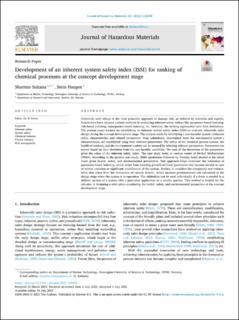| dc.description.abstract | Inherently safer design is the most proactive approach to manage risk, as referred by scientists and experts. Researchers have adopted various methods in evaluating inherent safety indices like parameter-based indexing, risk-based indexing, consequence-based indexing, etc. However, the existing approaches have their limitations. The present paper focuses on establishing an inherent system safety index (ISSI) to evaluate inherently safer design during the concept development stage. The analysis starts by identifying a non-harmful system's inherent safety characteristics and related parameters. Four subindexes, determined from the non-harmful system's characteristics, are established using their relevant parameters. The safety of the chemical process system, the health of workers, and the environment's safety can be assured by selecting relevant parameters. Parameters are scored based on their deviation from the non-harmful condition. The sum of the deviations of the parameters gives the value of the inherent safety index. The case study looks at various routes of Methyl Methacrylate (MMA). According to the present case study, MMA production followed by Tertiary butyl alcohol is the safest route given health, safety, and environmental perspective. This approach helps overcome the limitation of parameter-based indexing, which arises from selecting predefined fixed parameters that become invalid in case of system variation or significant modification of the system. Besides, it considers the complexity and vulnerability that arises from the interaction of various factors|, which increase predetermined risk calculated at the design stage when the system is in operation. The subindices can be used individually if a focus is needed in a definite section of a system with a particular application or a smaller portion. This method is helpful for the industry in designing a safer plant considering the health, safety, and environmental perspective at the concept development stage. | en_US |

